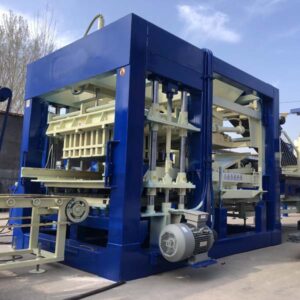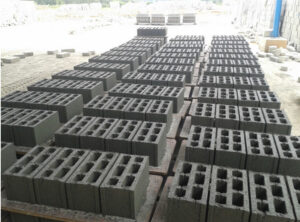Kenya, a land rich in natural resources and cultural diversity, has witnessed significant growth in its construction industry in recent years. This growth has been fueled by a booming economy, increasing urbanization, and a rising demand for housing and infrastructure. At the heart of this construction boom lies a crucial component: the brick. And the Kenya brick making machine has emerged as a key player in meeting this demand.
Kenya Brick Making Machine: A Catalyst for Construction and Development
The brick making machine in Kenya is not just a tool for producing bricks; it’s a symbol of technological advancement and industrialization. These machines have revolutionized the brick-making process, replacing the traditional, labor-intensive methods with efficient, automated systems. This shift has not only increased production capacity but also improved the quality of bricks, making them more durable and suitable for various construction needs.
The basic operation of a Kenya brick making machine is straightforward yet ingenious. The raw materials, typically a mix of soil, sand, and water, are fed into the machine. The machine then compresses the mixture under high pressure, forming it into uniform bricks. These bricks are then ejected from the machine, ready for use in construction projects.
The advantages of using a brick making machine in Kenya are numerous. Firstly, it significantly reduces the labor required for brick production. This not only saves time but also reduces the physical strain on workers. Secondly, the machine ensures a consistent quality of bricks, eliminating the inconsistencies that often arise with manual production. Finally, the high-pressure compression process creates bricks that are denser and stronger, improving the overall structural integrity of buildings.
The Kenya brick making machine also contributes to the country’s environmental sustainability efforts. By using locally available materials, it reduces the need for imported building materials, thus cutting down on transportation costs and carbon emissions. Additionally, the recycling of waste materials in brick production helps in waste management and resource conservation.
The brick making machine market in Kenya is rapidly expanding. With more and more entrepreneurs recognizing the potential of this industry, new players are entering the market, offering innovative and efficient machines. This competition has led to the development of machines with advanced features such as automatic feeding, adjustable brick sizes, and energy-efficient operations.
Moreover, the Kenyan government has also recognized the importance of the brick making industry and is providing support to encourage its growth. This includes providing subsidies and tax incentives to businesses investing in brick making machines, as well as promoting the use of locally produced bricks in public and private construction projects.
However, despite the significant progress made in the brick making industry in Kenya, there are still challenges that need to be addressed. One of the main challenges is the availability of raw materials. The quality and quantity of soil and sand available can vary significantly across different regions, affecting the production capacity and quality of bricks. Therefore, it’s crucial for brick makers to carefully source their raw materials and ensure their suitability for brick production.
Another challenge is the need for skilled operators to run the brick making machines. While the machines themselves are relatively easy to operate, they still require a certain level of technical knowledge and expertise. This means that brick makers need to invest in training their workers or hire skilled operators to ensure the efficient and safe operation of their machines.
Despite these challenges, the future looks promising for the Kenya brick making machine industry. With continued innovation and advancements in technology, we can expect to see even more efficient and sustainable machines entering the market. This, coupled with the increasing demand for housing and infrastructure, will create vast opportunities for brick makers to grow their businesses and contribute to the country’s economic development.
In conclusion, the Kenya brick making machine has played a pivotal role in the country’s construction industry, revolutionizing brick production and contributing to its overall growth and development. As the industry continues to evolve, we can expect to see even greater advancements in brick making technology, driving Kenya towards a more prosperous and sustainable future.
The brick making machine industry in Kenya is not just a local phenomenon; it’s a global trend that Kenya has successfully capitalized on. The machines are exported to neighboring countries, demonstrating Kenya’s technological prowess and industrial capabilities. This export market not only generates foreign exchange but also creates job opportunities and spurs economic growth.
Moreover, the Kenya brick making machine industry is also attracting foreign investors. These investors bring in capital, technology, and expertise, further boosting the industry’s growth and competitiveness. The collaboration between local entrepreneurs and foreign investors is creating a vibrant and dynamic brick making sector that is poised for even greater success in the future.
As the industry matures, there is also a growing focus on research and development. Manufacturers are investing in innovative technologies and materials to improve the efficiency, durability, and environmental sustainability of their machines. This research is not only leading to the development of new machines but also improving the performance of existing ones.
Moreover, the machines contribute to environmental sustainability. By using locally available materials such as soil and sand, they reduce the need for imported building materials, thus mitigating the environmental impact of long-distance transportation. Additionally, the bricks produced by these machines can be recycled, further enhancing their environmental friendliness.
The Kenyan government has also recognized the potential of brick making machines in promoting construction and development. It has implemented various policies and initiatives to encourage the adoption of these machines among brick manufacturers. This includes providing financial support, training programs, and technical assistance to small and medium-sized enterprises that are interested in adopting the technology.
As a result of these efforts, the brick making machine industry in Kenya has grown significantly. Manufacturers have invested in research and development, introducing new and improved models that are more efficient, reliable, and user-friendly. This innovation has further propelled the growth of the industry, attracting both domestic and foreign investors.
However, despite the progress made, there are still challenges facing the brick making machine industry in Kenya. One of the main challenges is the availability of raw materials. The quality and quantity of soil and sand can vary significantly across different regions, affecting the production capacity and quality of bricks. To address this issue, manufacturers need to explore alternative materials or develop techniques to enhance the properties of locally available materials.
Another challenge is the competition from imported bricks. Despite the advantages of locally produced bricks, some constructors still prefer imported bricks due to their perceived superior quality. To compete with imported products, Kenyan brick manufacturers need to continue improving the quality and variety of their products while also focusing on marketing and branding strategies to enhance their visibility and attractiveness.
In conclusion, the Kenya brick making machine has played a pivotal role in driving the construction and development of the country. Its impact is evident in the increased efficiency, improved quality, and environmental sustainability of the brick production process. With continued innovation and government support, the industry is poised to achieve even greater heights in the future, contributing significantly to the economic growth and social development of Kenya.
As the world becomes increasingly aware of the need for sustainable development, Cabo Verde’s brickmaking machines are expected to embrace environmentally friendly practices. Manufacturers will focus on using renewable energy sources such as solar and wind power to operate their machines, reducing their carbon footprint. Additionally, the use of recycled materials in brick production will become more widespread, minimizing the demand for virgin resources.
The development of eco-friendly brickmaking machines will also involve the adoption of closed-loop systems that minimize waste and maximize resource efficiency. This includes the implementation of waste recycling mechanisms that convert waste materials into useful by-products or energy. Such systems will not only help Cabo Verde’s brickmaking industry to become more sustainable but also contribute to the country’s overall environmental protection efforts.
